
![]()
 |
| Battery enclosure (partially buried) |
|---|
Field Evaluation of Batteries for Energy Storage
Researchers in the division monitor and perform periodic field evaluations of battery performance in actual operating systems to determine changes in battery capacity and lifetime. Data from these experiments are used to corroborate data from laboratory measurements and to compare the performance of different batteries and battery technologies in selected applications.
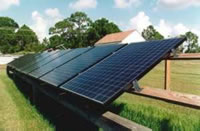 |
| PV field test site at FSEC |
|---|
Side-By-Side Testing of Energy Storage Options
Researchers are testing and evaluating approximately 40 small stand-alone PV systems, similar to solar home systems for developing countries, to assess the relative performance of battery storage subsystems. The PV community needs to better understand the long-term performance of various battery technologies under outdoor operating conditions.
 |
| Environmental chamber for testing PV lighting systems |
|---|
Laboratory Evaluation of Photovoltaic Lighting Systems and Components
FSEC tests and evaluates all critical components and subsystems of PV lighting systems, a major and growing application in Florida. It is important to assure product performance for the citizens of Florida by assisting industry in improving the quality of their products.
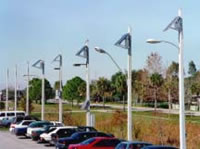 |
| PV lighting systems under test at FSEC |
|---|
On-Site Testing of Area Lighting Systems
Division staff test PV lighting systems to verify that prescribed performance specifications are met. Potential end users, especially buyers of large numbers of systems like utility companies, need assurance that the PV lighting systems they buy will meet their expectations.
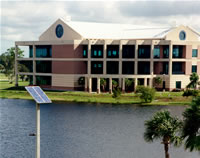 |
| PV lighting system under test at Brevard Community College |
|---|
Field Evaluation of Photovoltaic Lighting Systems
Researchers periodically inspect, test and evaluate lighting systems at various sites to make sure they are performing properly and to record any problems requiring maintenance, repair and replacement. Field evaluation of operating systems is an effective way of assessing the quality of both the delivered hardware and the system installation by providing a measure of both product and industry maturity.
 |
| Photovoltaic design assistance |
|---|
Photovoltaic Technical Support
Assistance is provided in the form of technical information, procurement specifications, product information, industry contacts, applications development, design review, acceptance testing and project implementation in collaboration with Sandia National Laboratories. Many users of photovoltaics have little or no prior experience with the technology. Providing technical assistance usually results in systems that better meet performance expectations and have greater reliability, thus improving consumer confidence.
 |
Training in Jamaica |
|---|
International Photovoltaic Training
The division’s international training activities include programs for engineers, technicians, and decision-makers in developing countries through short courses, workshops and technical assistance activities. Developing countries are a major market for U.S. suppliers of PV systems. The rate of expansion and eventual size of this market depends on the creation of an effective human resource infrastructure, which requires an on-going training effort.
 |
Training in Jamaica |
|---|
Web-Based Data and Information on Photovoltaic Systems
Data and information on actual tests conducted by FSEC and others are collected and disseminated to an international audience over the Internet. Interested parties need ready access to data from an independent laboratory like FSEC on PV system and component performance.
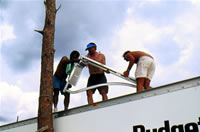 |
FSEC researchers send PV systems to |
|---|
Applying Photovoltaic Technology to Disaster Relief
FSEC staff have reviewed the history of PV use for disaster relief, conducted a survey of disaster organizations, performed a needs assessment, implemented a technical workshop, procured equipment for emergency organizations, provided training, and are evaluating the effectiveness of PV for various applications. The application of photovoltaic technology to disaster relief represents a niche market for the PV industry and results in much needed electrical power during emergencies.
Residential PV system in |
|---|
Monitoring of Utility-Owned Photovoltaic Residences
Research in this are has included development of design specifications, installation and acceptance test procedures and monitoring the performance of utility-interactive residential systems. This is a collaborative effort between the City of Lakeland, Siemens Solar Industries, Hutton Communications, Sandia National Laboratories, and the Florida Solar Energy Center. The City of Lakeland Electric will use performance and other data to evaluate the long-term business prospects for using residential PV systems for distributed power generation.
 |
A super energy-efficient, |
|---|
Evaluating Energy Efficient Photovoltaic Buildings
Staff have worked with the PV industry, a builder/developer, and a municipal utility to develop a PV-powered super-energy efficient home. FSEC is monitoring its PV power production and comparing its energy efficiency with a nearly identical conventional home. The model home will establish a benchmark for performance that should minimize the impact of the building electrical loads on utility peak demand. Data will also be used to establish a basis for providing energy ratings for PV residences.
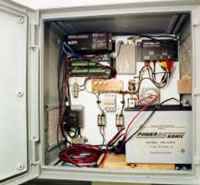 |
Level 1 monitoring of a PV system |
|---|
Developing Alternative Monitoring System Designs and Plans for Photovoltaic Buildings
This project involved the development of three alternative monitoring systems, from simple to more complex, for PV buildings. Information on these monitoring alternatives will be available to all interested parties nationwide. System monitoring allows the determination of the true cost and value of PV systems to better predict system performance for key user groups.
Metal roof panel with PV material |
|---|
Integrating Metal Roofs and Photovoltaic Arrays
Members of the division are working with builders, commercial roofing companies, PV industry, manufactured housing corporations and utilities to develop approaches, experiments and projects that will help us evaluate the desirability of integrating metal roofs and PV arrays. Applications include re-roofing, on-site construction, and manufactured housing. The life cycle economics of a PV system on a metal roof may be much more attractive than for a system on a more conventional roof. Likewise, most economic models do not include the penalty paid for re-roofing.
Design from the PV community |
|---|
Designing Fault and Weather-Tolerant Photovoltaic Buildings
Designs have been solicited for critical power systems for fault and weather-tolerant buildings from the PV design community. The buildings must operate with electric power when the utility is down. Homeowners, buyers and building owners are becoming increasingly interested in fault and weather-tolerant buildings that are capable of producing electric power for extended periods of time when there is an electrical outage, possibly due to severe weather.
 |
A12-k utility-interactive PV |
|---|
Evaluating Photovoltaics for Demand-Side Management
One project involves monitoring electrical power production from an 11-kW utility-interactive PV system and comparing it to the electrical demand for FSEC's new office building. Staff are also investigating interconnection issues, including personnel safety, equipment protection, and power quality. These experiments will provide useful information to utilities about the potential for PV to reduce peak loading from commercial building operations, and will provide valuable information for establishing reasonable interconnection requirements.
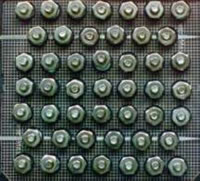 |
PV Module encapsulant adhesive |
|---|
Module Durability Research
Researchers are taking core samples of new and exposed module laminates through selected regions of cells to determine adhesion strength and identify degradation processes at the microscopic level. Better understanding of delamination and other degradation processes will help industry in improving manufacturing processes and products.
